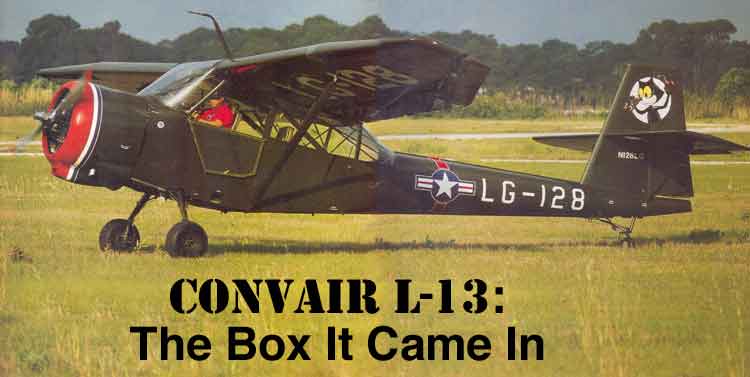
 |
PAGE TWO
After the L-13 was discharged, the airplane practically disappeared. For a very short period of time, there were a few running around with glider tow hooks or working for bush operators. In the main, they quickly vanished into that great aviation blackhole where airplanes go to die. Oddly enough, it seemed as if they herded together to die since, for awhile, Southern California had caches of anywhere from two to a half dozen of them huddled together in weed-covered airport corners or in fenced-in compounds zealously guarded by those airplane hoarding eccentrics that seem to populate aviation's fringes. By the 1970s, the airplanes has so completely disappeared it was difficult to find anyone which whom a meaningful conversation could be held. The L-13 had fallen through a crack in aviation's memory bank. Being an enthusiast of the stranger variety of STOL airplanes, the L-13 has always struck a responsive chord — probably going back to the 1960s when I would climb into a derelict L-13 that was one of a trio of semi-hulks on California's famed San Fernando Valley Airport. It seemed as if the airplane had bushels of character. Actually, because of the L-13's size, it has bushels of everything! Although rumors of L-13 restoration projects have been floating around for the last several years, it wasn't until I stumbled across (actually one does not "stumble" across something as big as an L-13) Dan O'Connell's airplane at Sun 'n Fun that I realized the rumors were true. Painted in olive drab, rather than the monochromatic silver, most of them carried during their Air Force career and sporting the Lycoming R-680, it not only reawakenedthose old San Fernando feelings but was absolutely one of the more unusual, overlooked airplanes on the flight line. That's sad, considering how hard it is to ignore an airplane that looks vaguely like an L-19 Bird Dog with the decimal point moved over one place. Parked with the rest of the L-birds, the L-13 stood head and shoulders, cockpit and wing, above them. This was definately the heavy iron representative of the Warbug community. It took awhile to track O'Connell down but, when we did, we agreed to meet at Winter Haven on his way back to his homebase in south Florida. He said the trip was long enough that he wanted to take several days. I didn't think too much about the comment, although I knew homebase wasn't but 400 miles south. The next morning, as I drove into the delightful airport that is Winter Haven, I saw what he meant. As I approached, I saw a darkish-colored lump hanging over the airport that I first mistook for a helicopter because it appeared to be hovering. As I drew closer (the bump didn't appear to be moving) I could see it was the L-13 valiantly fighting a 20 knot headwind to gain position on downwind. If I thought the airplane had looked funky sitting on the War-bird line in Lakeland, it looked positively alien parked at the pump amid all the Spam cans at Winter Haven. It appeared as if the airplane had grown even more over night. As I walked up to the L-13, I was conscious of having to stretch to look in the pilot's side window. I was even more aware of looking up to examine the horizontal stabilizer attach fittings to see which direction they folded. This is definately not your average Warbug. O'Connell is a general contractor and explained he had been in the Air Force as a B-36 crewman at the same time the L-13s were in service — which had little or nothing to do with why he bought the airplane. As he put it, one day he was looking around and realized there were a limited number of pages left on his calendar so if he was going to do what he wanted to do, he'd better do it now. He had been out of aviation for a number of years, when he contacted Jack Yount, well-known south Florida aircraft broker, when he saw the L-13 for sale. When he arrived at Sun 'n Fun with Jack, he'd had the air-plane for only six months and hadn't flown it enough to be comfortable. For that reason, he trusted his airplane and the check out process to Jack Yount, who had flown the L-13 quite a bit. To gain an appreciation for the size of the machine, one must realize the bottom of the door is past waist high to the average man, which makes climbing into the airplane exactly that — climbing. There were only brakes on the left side, so I scurried around to the right and clambered up, noting as I did that, even though the airplane is configured essentially like an L-19, its cockpit falls more into the cabin-class category — making for a true flight deck. |